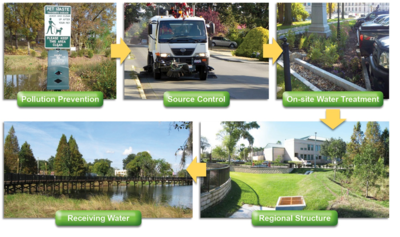
Difference between revisions of "Category:Level 2 - Best management practices/Structural practices"
(Created page with "File:Watershed scale stormwater treatment train.PNG|thumb|400px|alt=photo illustrating a watershed scale treatment train approach using a multi-BMP approach to managing the...") |
m |
||
| Line 2: | Line 2: | ||
A structural stormwater <span title="One of many different structural or non–structural methods used to treat runoff"> '''best management practice'''</span> (BMP) is defined in the [https://stormwater.pca.state.mn.us/index.php?title=Stormwater_Program_for_Municipal_Separate_Storm_Sewer_Systems_(MS4) MS4 General permit] as "a stationary and permanent BMP that is designed, constructed and operated to prevent or reduce the discharge of pollutants in stormwater". Examples include <span title="Bioretention, also called rain gardens, is a terrestrial-based (up-land as opposed to wetland) water quality and water quantity control process. Bioretention employs a simplistic, site-integrated design that provides opportunity for runoff infiltration, filtration, storage, and water uptake by vegetation. Bioretention areas are suitable stormwater treatment practices for all land uses, as long as the contributing drainage area is appropriate for the size of the facility. Common bioretention opportunities include landscaping islands, cul-de-sacs, parking lot margins, commercial setbacks, open space, rooftop drainage and street-scapes (i.e., between the curb and sidewalk). Bioretention, when designed with an underdrain and liner, is also a good design option for treating Potential stormwater hotspots. Bioretention is extremely versatile because of its ability to be incorporated into landscaped areas. The versatility of the practice also allows for bioretention areas to be frequently employed as stormwater retrofits."> '''bioretention'''</span>, <span title="Permeable pavements allow stormwater runoff to filter through surface voids into an underlying stone reservoir for temporary storage and/or infiltration. The most commonly used permeable pavement surfaces are pervious concrete, porous asphalt, and permeable interlocking concrete pavers (PICP)."> '''[https://stormwater.pca.state.mn.us/index.php?title=Permeable_pavement permeable pavement]'''</span>, <span title="Green roofs consist of a series of layers that create an environment suitable for plant growth without damaging the underlying roof system. Green roofs create green space for public benefit, energy efficiency, and stormwater retention/ detention."> '''[https://stormwater.pca.state.mn.us/index.php?title=Green_roofs green roof]'''</span>, and <span title="Are configured as shallow, linear channels. They typically have vegetative cover such as turf or native perennial grasses"> [https://stormwater.pca.state.mn.us/index.php?title=Dry_swale_(Grass_swale) '''swales''']</span>. | A structural stormwater <span title="One of many different structural or non–structural methods used to treat runoff"> '''best management practice'''</span> (BMP) is defined in the [https://stormwater.pca.state.mn.us/index.php?title=Stormwater_Program_for_Municipal_Separate_Storm_Sewer_Systems_(MS4) MS4 General permit] as "a stationary and permanent BMP that is designed, constructed and operated to prevent or reduce the discharge of pollutants in stormwater". Examples include <span title="Bioretention, also called rain gardens, is a terrestrial-based (up-land as opposed to wetland) water quality and water quantity control process. Bioretention employs a simplistic, site-integrated design that provides opportunity for runoff infiltration, filtration, storage, and water uptake by vegetation. Bioretention areas are suitable stormwater treatment practices for all land uses, as long as the contributing drainage area is appropriate for the size of the facility. Common bioretention opportunities include landscaping islands, cul-de-sacs, parking lot margins, commercial setbacks, open space, rooftop drainage and street-scapes (i.e., between the curb and sidewalk). Bioretention, when designed with an underdrain and liner, is also a good design option for treating Potential stormwater hotspots. Bioretention is extremely versatile because of its ability to be incorporated into landscaped areas. The versatility of the practice also allows for bioretention areas to be frequently employed as stormwater retrofits."> '''bioretention'''</span>, <span title="Permeable pavements allow stormwater runoff to filter through surface voids into an underlying stone reservoir for temporary storage and/or infiltration. The most commonly used permeable pavement surfaces are pervious concrete, porous asphalt, and permeable interlocking concrete pavers (PICP)."> '''[https://stormwater.pca.state.mn.us/index.php?title=Permeable_pavement permeable pavement]'''</span>, <span title="Green roofs consist of a series of layers that create an environment suitable for plant growth without damaging the underlying roof system. Green roofs create green space for public benefit, energy efficiency, and stormwater retention/ detention."> '''[https://stormwater.pca.state.mn.us/index.php?title=Green_roofs green roof]'''</span>, and <span title="Are configured as shallow, linear channels. They typically have vegetative cover such as turf or native perennial grasses"> [https://stormwater.pca.state.mn.us/index.php?title=Dry_swale_(Grass_swale) '''swales''']</span>. | ||
| + | |||
| + | [[Category:Level 1 - Best Management practices]] | ||
Revision as of 18:16, 12 July 2022
A structural stormwater best management practice (BMP) is defined in the MS4 General permit as "a stationary and permanent BMP that is designed, constructed and operated to prevent or reduce the discharge of pollutants in stormwater". Examples include bioretention, permeable pavement, green roof, and swales.
Subcategories
This category has the following 13 subcategories, out of 13 total.
L
- Level 3 - Best management practices/Nonstructural practices/Harvest and reuse
- Level 3 - Best management practices/Structural practices/Bioretention
- Level 3 - Best management practices/Structural practices/Dry swale
- Level 3 - Best management practices/Structural practices/Green roof
- Level 3 - Best management practices/Structural practices/Harvest and reuse
- Level 3 - Best management practices/Structural practices/Infiltration (trench/basin)
- Level 3 - Best management practices/Structural practices/Iron enhanced sand filter
- Level 3 - Best management practices/Structural practices/Permeable pavement
- Level 3 - Best management practices/Structural practices/Sand filter, iron enhanced sand filter, media filter
- Level 3 - Best management practices/Structural practices/Step pool
- Level 3 - Best management practices/Structural practices/Tree trench and box
- Level 3 - Best management practices/Structural practices/Wet pond
- Level 3 - Best management practices/Structural practices/Wet swale
Pages in category "Level 2 - Best management practices/Structural practices"
The following 4 pages are in this category, out of 4 total.
